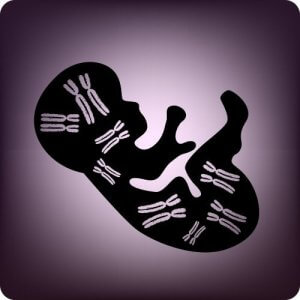Prenatal Genetic Testing: Characteristics and Advantages

Every day, more and more women are opting for prenatal genetic testing during their first trimester of pregnancy. This testing allows for the detection of genetic anomalies in their developing child. In most cases, the results are negative. However, a small percentage of embryos present some type of genetic anomaly.
What to do in the case of a positive test result may be one of the most difficult decisions in a woman’s life. To help you, today’s article will analyze the information that prenatal genetic testing provides.
What is prenatal genetic testing?
Prenatal genetic testing is a non-invasive test that pregnant women can undergo as soon as their 10th week of gestation. A specialist extracts a small amount of the mother’s blood in order to detect possible anomalies in the DNA of her fetus. Mainly, this test detects three types of trisomies (the appearance of an extra chromosome in a homologous chromosome pair):
- Trisomy 21, or Down Syndrome. This is the most common genetic condition. It occurs spontaneously and involves a mild or moderate intellectual delay. Individuals with Down Syndrome share particular physical characteristics.
- Trisomy 18, or Edwards Syndrome. Edwards Syndrome is a rare genetic condition that occurs in 1 in every 13,000 births. In this case, the risk of miscarriage is very high. These children present buccofacial anomalies as well as clinical cranioencephalic alterations. These alterations affect their growth and reduce their life expectancy considerably.
- Trisomy 13, or Patau Syndrome. This is a rare hereditary genetic condition. It’s associated with malformations of the nervous system, head, neck, heart, and extremities (hands and feet). The survival rate for children born with Patau Syndrome is less than one year.

Depending on the results of prenatal genetic testing, further diagnostic testing may be necessary. In any case, the decision regarding what process to follow will depend on the moment in which testing takes place as well as the urgency of obtaining further results.
The characteristics and advantages of prenatal genetic testing
Prenatal genetic testing is characterized as being a non-invasive test with a practically nonexistent risk for miscarriage. The test involves a simple extraction of the mother’s blood for analysis. Furthermore, it’s nearly 100% precise, meaning it provides clear and definitive results.
Because this testing is non-invasive, any woman is eligible. Age, body mass, pregnancy type (single, twins, triplets, etc) and gestation method aren’t deciding factors. Nor does it matter whether a woman conceived naturally or with assistance.
At the same time, prenatal genetic testing doesn’t just provide information regarding the genetic disorders mentioned above. The latest tests can even detect micro chromosomal deletions or genetic anomalies of sex chromosomes.
Other prenatal testing
There are two types of prenatal tests that women can undergo while pregnant. These are screening tests and diagnostic tests. Screening tests evaluate the risk of the possible presence of an anomaly.
However, the results aren’t definitive, meaning they don’t reveal with certainty whether or not a child possesses a genetic anomaly – just the chances that he or she may. Diagnostic tests, on the other hand, confirm said suspicion.
Screening tests
- Carrier screening tests. These tests analyze the genomes of both parents in order to detect hereditary disorders. This testing can take place before or after pregnancy.
- Ultrasounds. The most important ultrasound takes place during the 20th week of gestation. The images allow specialists to observe any problems in the development of the fetus.

Diagnostic testing
- Chorionic villus sampling. This test takes place between weeks 10 and 13 of gestation if a risk of malformation exists. In this case, specialists conduct testing on a sample of tissue from the placenta.
- Amniocentesis. This test is considered to be invasive. The purpose here is to detect chromosomal anomalies between 15 and 20 weeks of gestation.
- Nuchal Translucency scan. Here, ultrasound technicians measure the back of the fetus’s neck in order to detect cardiovascular disorders in the fetus.
- Pre-implantation genetic diagnosis. In general, couples who opt for in vitro fertilization and who have a history of genetic diseases undergo this sort of testing. The test allows for the identification of genetic defects in embryos in order to prevent those defects from being passed on to the future child.
In conclusion…
Prenatal genetic testing is a very good alternative to amniocentesis. This is because it presents no risk to pregnant mothers and their babies and because accuracy is very high.
However, the only downside we can see to this test is the stress and anguish that unfavorable results may cause parents… especially those with less access to the latest technology in genetic testing.
“UHC (Universal Health Coverage) means that all individuals and communities receive the health services they need without suffering financial hardship”.
– World Health Organization –
Every day, more and more women are opting for prenatal genetic testing during their first trimester of pregnancy. This testing allows for the detection of genetic anomalies in their developing child. In most cases, the results are negative. However, a small percentage of embryos present some type of genetic anomaly.
What to do in the case of a positive test result may be one of the most difficult decisions in a woman’s life. To help you, today’s article will analyze the information that prenatal genetic testing provides.
What is prenatal genetic testing?
Prenatal genetic testing is a non-invasive test that pregnant women can undergo as soon as their 10th week of gestation. A specialist extracts a small amount of the mother’s blood in order to detect possible anomalies in the DNA of her fetus. Mainly, this test detects three types of trisomies (the appearance of an extra chromosome in a homologous chromosome pair):
- Trisomy 21, or Down Syndrome. This is the most common genetic condition. It occurs spontaneously and involves a mild or moderate intellectual delay. Individuals with Down Syndrome share particular physical characteristics.
- Trisomy 18, or Edwards Syndrome. Edwards Syndrome is a rare genetic condition that occurs in 1 in every 13,000 births. In this case, the risk of miscarriage is very high. These children present buccofacial anomalies as well as clinical cranioencephalic alterations. These alterations affect their growth and reduce their life expectancy considerably.
- Trisomy 13, or Patau Syndrome. This is a rare hereditary genetic condition. It’s associated with malformations of the nervous system, head, neck, heart, and extremities (hands and feet). The survival rate for children born with Patau Syndrome is less than one year.

Depending on the results of prenatal genetic testing, further diagnostic testing may be necessary. In any case, the decision regarding what process to follow will depend on the moment in which testing takes place as well as the urgency of obtaining further results.
The characteristics and advantages of prenatal genetic testing
Prenatal genetic testing is characterized as being a non-invasive test with a practically nonexistent risk for miscarriage. The test involves a simple extraction of the mother’s blood for analysis. Furthermore, it’s nearly 100% precise, meaning it provides clear and definitive results.
Because this testing is non-invasive, any woman is eligible. Age, body mass, pregnancy type (single, twins, triplets, etc) and gestation method aren’t deciding factors. Nor does it matter whether a woman conceived naturally or with assistance.
At the same time, prenatal genetic testing doesn’t just provide information regarding the genetic disorders mentioned above. The latest tests can even detect micro chromosomal deletions or genetic anomalies of sex chromosomes.
Other prenatal testing
There are two types of prenatal tests that women can undergo while pregnant. These are screening tests and diagnostic tests. Screening tests evaluate the risk of the possible presence of an anomaly.
However, the results aren’t definitive, meaning they don’t reveal with certainty whether or not a child possesses a genetic anomaly – just the chances that he or she may. Diagnostic tests, on the other hand, confirm said suspicion.
Screening tests
- Carrier screening tests. These tests analyze the genomes of both parents in order to detect hereditary disorders. This testing can take place before or after pregnancy.
- Ultrasounds. The most important ultrasound takes place during the 20th week of gestation. The images allow specialists to observe any problems in the development of the fetus.

Diagnostic testing
- Chorionic villus sampling. This test takes place between weeks 10 and 13 of gestation if a risk of malformation exists. In this case, specialists conduct testing on a sample of tissue from the placenta.
- Amniocentesis. This test is considered to be invasive. The purpose here is to detect chromosomal anomalies between 15 and 20 weeks of gestation.
- Nuchal Translucency scan. Here, ultrasound technicians measure the back of the fetus’s neck in order to detect cardiovascular disorders in the fetus.
- Pre-implantation genetic diagnosis. In general, couples who opt for in vitro fertilization and who have a history of genetic diseases undergo this sort of testing. The test allows for the identification of genetic defects in embryos in order to prevent those defects from being passed on to the future child.
In conclusion…
Prenatal genetic testing is a very good alternative to amniocentesis. This is because it presents no risk to pregnant mothers and their babies and because accuracy is very high.
However, the only downside we can see to this test is the stress and anguish that unfavorable results may cause parents… especially those with less access to the latest technology in genetic testing.
“UHC (Universal Health Coverage) means that all individuals and communities receive the health services they need without suffering financial hardship”.
– World Health Organization –
All cited sources were thoroughly reviewed by our team to ensure their quality, reliability, currency, and validity. The bibliography of this article was considered reliable and of academic or scientific accuracy.
- Asociación de Anomalías y Malformaciones Dentofaciales (última consulta junio 2019). Entendiendo al paciente con Síndrome de Edwuards. [artículo en web]. Recuperado de: www.aamade.com
- Down España (última consulta junio 2019). El síndrome de Down [artículo en web]. Recuperado de: www.sindromedown.net
- Asociación Humanitaria de Enfermedades Degenerativas y Síndrome de la Infancia y la Adolescencia (última consulta junio 2019). Síndrome de Patau [artículo en web]. Recuperado de: www.ahedysia.org
- Colegio Americano de Obstetras y Ginlecólogos (mayo 2017). Pruebas genéticas de diagnósticos prenatales [folleto en web]. Recuperado de: www.acog.org
- Eunice Kennedy Shriver National Institute of Child Health and Human Development (última consulta junio 2019) Pruebas durante el embarazo [artículo en web]. Recuperado de: www.nichd.nih.gov
This text is provided for informational purposes only and does not replace consultation with a professional. If in doubt, consult your specialist.








